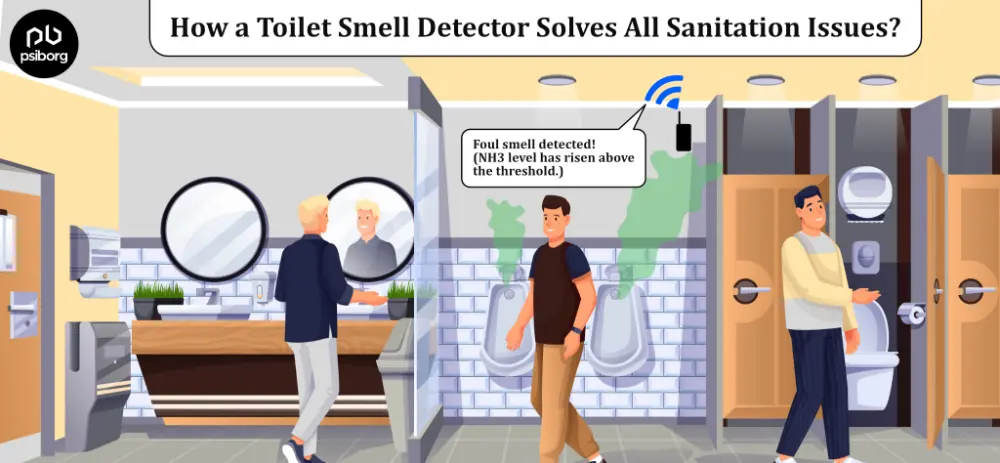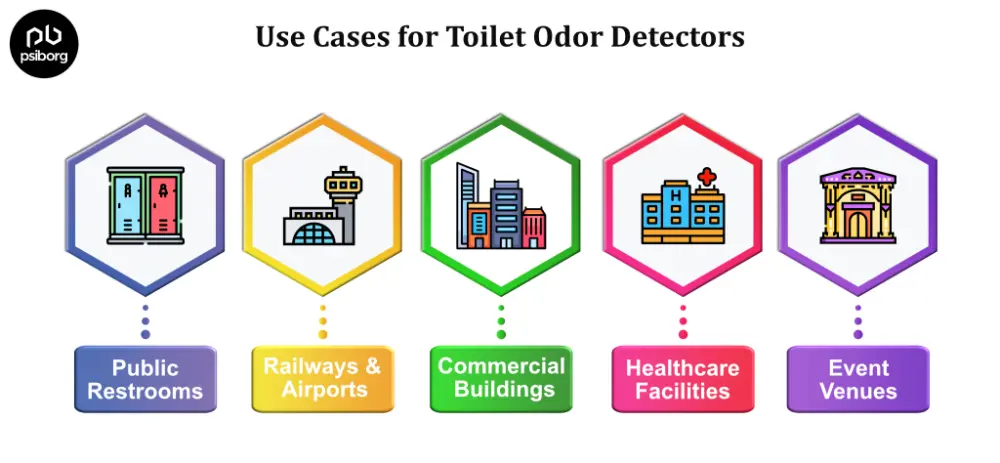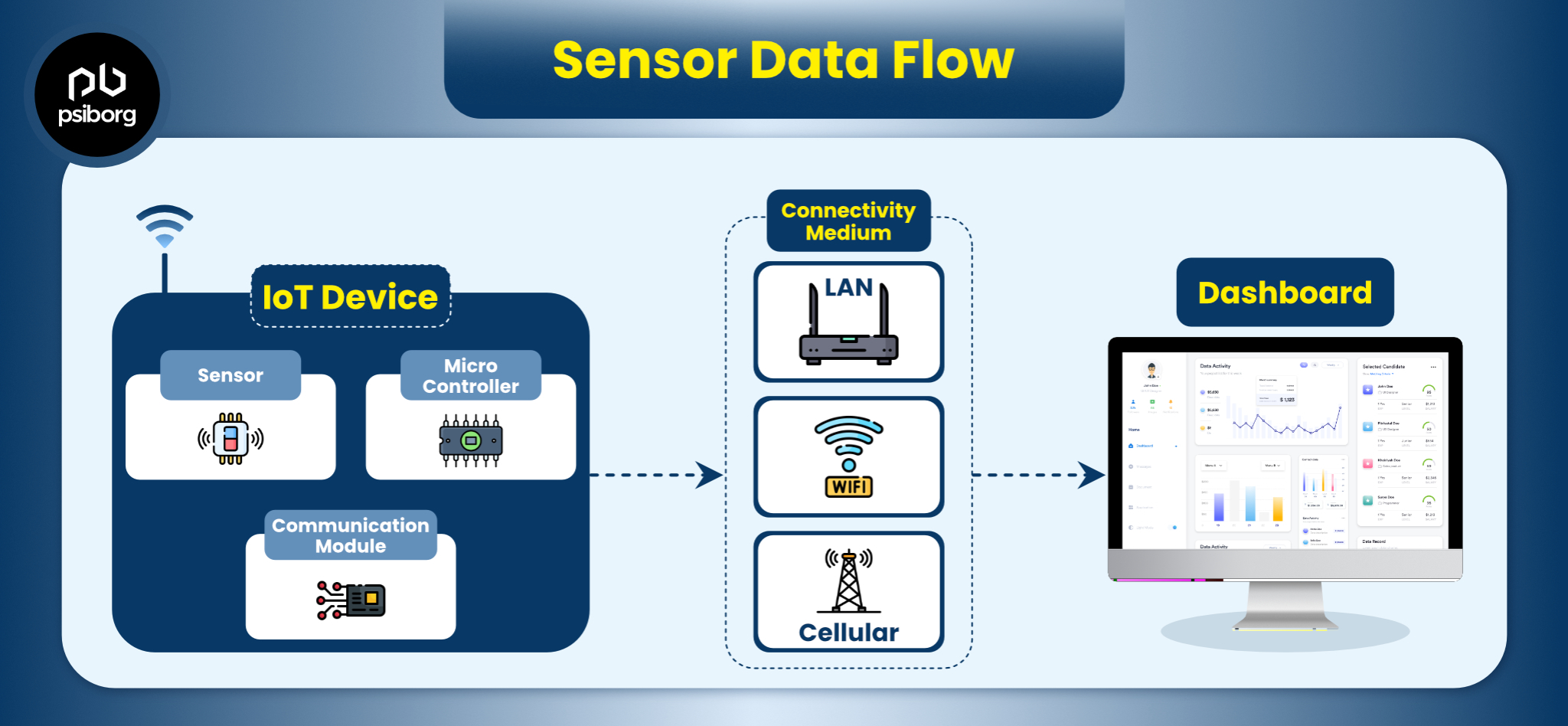No one would want to use a stinking washroom. We think twice and thrice before entering a public toilet, because of all the choking smell and unhygienic environment. Public toilets are always the worst because of the number of users and are often overlooked, even though they’re a very common facility in every sector.
But now, with the technical advancements and boom of IoT, there have emerged smart IoT solutions and sensors such as toilet smell detectors to detect foul smells in toilets.
These smart solutions come in the form of smart toilet monitoring systems and as an IoT development service providing company, let us explain how a toilet smell detector and a smart restroom solution work.
Because there is still this unfilled need for an all-around sensor-based technology that can take care of this stinking problem in public spaces like railway stations, airports, and retail stores.
After this blog, it will be easy for you to decide whether to install toilet smell detectors or not.
A Little About Toilet Smell Detectors
It’s very evident by the term, “a toilet smell detector” detects foul smell in restrooms. The toilet smell detectors use sensors to detect unpleasant gases like ammonia, and hydrogen sulfide, which are the main cause of the stinking smell.
Now, why do public toilets in railway stations, airports, and retail stores need smart toilet monitoring systems with toilet smell detectors?
Well, we all know the dilemma we face when it’s about using public toilets, all this because of the unhygienic environment.
The issue that we are talking about here is not new, but the solution to this issue is surely new, advanced, and much better than any other solution.
Just imagine a world where the public restrooms are consistently fresh and inviting. No more holding your breath. This vision is possible through smart toilet monitoring systems and IoT based odor detectors.
Moreover, improper ventilation, a high influx of people, and poor management of public toilets are the main reasons for indoor air contamination in public toilets.
To reduce exposure to air contamination, the new advanced step is the development of air quality measuring devices.
These devices offer continuous monitoring of air quality data and help cleaning staff in taking necessary steps based on the data.
How does the system work?

To explain simply, the odour detection system in toilets detects the specific compound that releases the odor. As soon as the concentration exceeds the set threshold value, an alert will be sent to the cleaning staff in the form of an alarm or notification, and exhaust will start.
However, here’s the stepwise working of the entire smell detector system:
1. The detector uses sensors, mostly electrochemical and TVOC sensors, to detect a wide range of volatile organic compounds and specific gases.
2. The sensors have a set level for how much odor is acceptable. If the odor level touches the threshold, the detector triggers exhaust fans. For instance, the presence of ammonia should be less than 25 ppm, for H2S should be 0-200 ppm, for SO2 the value shouldn’t be more than 1 ppm, and in the case of CO, the value shouldn’t exceed 70 ppm.
3. Besides this, the system also sends alerts in the form of lights, buzzers, phone notifications, and SMS to the cleaning staff. The system offers a variety of notification options such as smartphone notifications, cloud-based monitoring, and a light indication system.
Smart Toilet Monitoring System using IoT
A smart toilet monitoring system offers much more than just detecting toilet smells. Traditionally, a toilet is cleaned at fixed intervals but there are instances when a toilet needs cleaning even if it’s not yet the cleaning schedule.
A smart toilet monitoring system helps in detecting such situations so that cleaning staff can take action timely.
Odor detection is a critical component in a toilet monitoring system. But beyond this, a smart toilet monitoring system uses a broad range of sensors to fully eliminate stinks in toilets:
- Temperature & Humidity Sensors
- Occupancy Sensors
- Pressure sensors
- Bin level sensor
- Leak detection sensor
- Soap dispenser sensor
- Wet floor detector sensor
- Air quality detection sensors
- Rating and feedback panel
By integrating above-mentioned sensors, the systems can provide a comprehensive picture of the restroom environment, resulting in a more efficient, hygienic, and user-friendly experience.
Benefits of Toilet Odor Detectors
The implementation of toilet odor detectors offers a multitude of benefits:
1. Better Hygiene
These toilet odor detectors help keep restrooms smelling fresh, which makes the area cleaner and more hygienic.
2. Improved User Experience
Pleasant-smelling restrooms contribute to a more positive user experience, especially in high-traffic areas like public buildings, offices, or transportation hubs.
3. Early Issue Detection
By spotting possible plumbing issues before they become serious, the smart toilet monitoring system helps avoid unhygienic conditions and saves money on expensive repairs.
4. Timely Maintenance
The system collects data on odor levels over time, allowing for predictive maintenance and resource optimization.
Use Cases for Toilet Odor Detectors and Smart Toilet Monitoring Systems

Here’s a brief explanation of the several use cases of a smart toilet monitoring system are:
Public Restrooms
In high-traffic restrooms, early detection of odors allows for timely cleaning, thus ensuring a consistently pleasant experience for users. By concentrating on the areas that are most in need of cleaning, data on usage trends and odor levels can help assign resources more wisely.
Railways and Airports
Maintaining clean restrooms is challenging due to the high volume of passengers. Smart systems maximize cleaning schedules, detect possible plumbing problems before they become serious, and maintain cleanliness during periods of high turnover. Water conservation efforts are aided by leak detection and monitoring usage patterns. The overall passenger experience is improved with clean and fresh restrooms.
Also Read: Smart Railways Using IoT
Commercial Buildings
Clean, odor-free restrooms leave a good impression on guests, clients, and staff. This way, predictive maintenance based on sensor data prevents costly breakdowns and repairs to toilets and plumbing systems.
Healthcare Facilities
Restrooms must be kept sanitary and clean to prevent infections and preserve patient health. The odor detection system in the restroom maintains standards of cleanliness. It prevents infections, and improves patient welfare, guaranteeing the best possible hygiene in medical facilities.
Event Venues
Real-time data on occupancy and odor levels can help cleaning staff prioritize areas that need attention during large events. Fresh restrooms contribute to a more enjoyable experience for event attendees.
These are just a few examples, and the potential applications for toilet odor detectors and smart toilet monitoring systems continue to grow.
Indore Uses Toilet Smell Sensors for Swacch Indore Mission
One real-life use case of a toilet smell detector is Indore City.
Indore always ranks as the cleanest city in India. In order to maintain that position, the IMC (Indore Municipal Corporation), decided to go high-tech for monitoring and maintaining public toilets.
Even though the city had more than 300 community and public restrooms and the cleaning crew used to check the restrooms three times a day, there were still problems with sanitation.
Thus, the officials decided on an IoT solution: a toilet smell detector that uses ammonia sensors to detect the presence of ammonia, which is the main culprit of the stinking smell.
Using a mobile app, the odour level is tracked in real-time, and cleaning staff can respond timely to any alerts that are received.
Since the installation of smart sensors in five public restrooms proved to be effective. All public restrooms in the city of Indore will now have toilet smell detectors installed.
To Conclude,
This IoT-based toilet smell detector and smart toilet monitoring system align perfectly with the government’s “Swacch Bharat Mission” so it’s in need of an hour.
As technology advances, we can expect even smarter toilet monitoring systems with features like- self-cleaning toilets, waste management systems, and even voice-activated controls.
PsiBorg Technologies develops such smart IoT solutions to aid businesses that aim to provide sustainable and effective services to their users.
We develop custom smart washroom management systems using IoT and toilet smell detectors. These solutions can easily be integrated into communities and public toilets all across airports, railway stations, and commercial buildings.
Nevertheless, get in touch with us to talk about your requirements, and together we can explore how we can help you achieve those goals.
FAQs
An odor sensor is deployed in toilets to detect foul, stinking smells in the restroom environment. Generally, the odor sensor uses gas-sensing technology to identify the concentration of the stinking compounds, alerting the cleaning officials to schedule bathroom toilet cleaning and activating the ventilation system.
Yes, there are several sensors that are used to detect stinking odors in toilets. These sensors analyze the chemical composition of the air and measure the concentration of compounds like ammonia (NH3) and hydrogen sulfide (H2S).
The only effective way to get rid of the unpleasant smell in the toilet is by using an IoT based toilet smell detector.
Here, the smart toilet detector system uses smell sensors to detect the presence of ammonia, hydrogen sulfide, and sulphur dioxide inside the toilet environment and alerts the cleaning staff to take action.
You can get rid of smells with IoT-based toilet smell detectors that are integrated with purifiers or ventilation systems. The aforementioned detectors monitor indoor air quality in real-time and activate ventilation or purifiers when unpleasant smells are detected, ensuring a fresh, odor-free restroom environment automatically.






